I’m New Here: Week Twenty-Nine… a.k.a. Peter Pan and the House of Lords
September 5, 2019 by Stephanie Williams · Leave a Comment
 I can find no connection between my two items of interest for this week, except they were both published in the 1700’s. Consequently, I’ll provide a separate space for each, and invite a bit of interaction from any potential readers out there – proposing some sort of link between disparate finds.
I can find no connection between my two items of interest for this week, except they were both published in the 1700’s. Consequently, I’ll provide a separate space for each, and invite a bit of interaction from any potential readers out there – proposing some sort of link between disparate finds.
My first encounter was prompted by a question from a purchaser wanting to know how much content was in the Account of Peter the Wild Boy highlighted within “The Gentleman’s Magazine” of February, 1785. I have a high degree of appreciation for the GM’s, and I particularly enjoy the questions/quests that require me to read a bit of the impressive material that passes through my fingertips. It felt enough like shirking that I offered an audible comment to the general vicinity, “So-and-so wants me to check the article length,” but it is legitimately in my job description.
At any rate, this 1782 report was three columns long, and led to my current conjecture that J.M. Barrie somehow had access to it as the inspiration for Neverland’s perpetually young ruler. Within the description by Lord Monboddo are the two sentences that utterly convinced me. “He is but low of stature, not exceeding five feet three inches; and …has a fresh healthy look. His face is not at all ugly or disagreeable; and he has a look that may be called sensible and sagacious for a savage.” Surely this is the Lost Boy, Peter Pan!
Then, in an unrelated moment, I processed an order for five of the “Acts of Parliament”. I felt confident that I could pull this portion from one of the more obscure locations, having sat down on the floor to look through these just a few weeks ago. It’s a bit challenging to become acclimated to the outmoded spelling, particularly when it’s obscured by calligraphy type, but persistence uncovers some true gems. The Act “for the further Qualification of Justices of the Peace” claims “That no Attorney, Solicitor, or Proctor(?), in any Court whatsoever, shall, from and after the said Twenty fifth Day of March, One thousand seven hundred and thirty three, be capable to continue to be a Justice of the Peace, within any County for that part of Great Britain called England, or the Principality of Wales…” Which might sound enlightened for the time, until the second to last paragraph which reads, “Provided always, That nothing in this Act contained shall extend to incapacitate any Peer or Lord of Parliament, or the elder Son or heir apparent of any Peer or Lord of Parliament, or of any Person qualified to serve as Knight of a Shire …”.
And, with that, the Middle Ages shadows this august body more than I anticipated from my modern perch. Throughout random samplings of the Acts, this juxtaposition continues in the strange mix of rote tradition and civilized advancement, reflecting sessions that directly impact worldwide legal systems of today.
And I knew where to find them. 🙂
I’m New Here…Weeks Nine & Ten
April 19, 2019 by Stephanie Williams · 1 Comment
Since my entries are personal perspective, and this is a significant week in the Christian calendar, my post carries a tinge of my own religious convictions. Please skip reading if such things offend you. After today I’ll endeavor to quash my worldview until a similar time next year…
There are newspapers inventoried in this facility that are so old they preceded the term, and are referred to by those in the know as a newsbook or a “coronto”. At least, that is my sketchy understanding. This week I am thinking about things that have survived generations, inventions, wars and cosmic changes. The listing that caught my eye was a title from 1629, banned in 1632 –but then given special license to continue six years later. Wikipedia says, “In 1638 they were granted a patent from King Charles I for the publication of news and history, in return for a £10 annual donation toward the upkeep of St. Paul’s Cathedral…” And, of course, I wanted to see this for myself. The small volume sold in 2015, just days after it was made available, but I was able to find a German newsbook from 1607 that I could look at. It wasn’t in a vault, but neatly cataloged and filed with all the other items in the seventeenth century inventory. There are so many treasures, I suppose a vault would have to be the size of a warehouse — which indeed it is. AUSSFUHRLICHER BERICHT was accessible, and I was able to pull the folder, open it on a surface, and even lift the clear archival cover in order to take a photograph without the obstruction of a reflected glare. Not many people have the privilege of holding a publication that is over four hundred years old, and I know myself to be ridiculously undeserving.
 But this week Paris has superimposed itself on my mental wanderings. As for much of the western world, images of flames engulfing an icon that has stood for eight hundred years are incomprehensible. At a certain point old things seem to become everlasting. Particularly, stone cathedrals are expected to survive history itself. Invasion, famine, revolution and disease have moved around that block work for nearly a millennium. But we have records here at History’s Newsstand of many seemingly immovable things that have eventually yielded, and those accounts are interspersed with all the common themes of humanity that seem unhampered by the passage of time.
But this week Paris has superimposed itself on my mental wanderings. As for much of the western world, images of flames engulfing an icon that has stood for eight hundred years are incomprehensible. At a certain point old things seem to become everlasting. Particularly, stone cathedrals are expected to survive history itself. Invasion, famine, revolution and disease have moved around that block work for nearly a millennium. But we have records here at History’s Newsstand of many seemingly immovable things that have eventually yielded, and those accounts are interspersed with all the common themes of humanity that seem unhampered by the passage of time.
This is the week that Notre Dame burned. It is also the week before Easter — the darkness and mourning of “Good Friday” so closely followed by the joyful resurrection of Easter Sunday.
There is destruction and devastation, but there is also redemption. It’s the common cycle of the accounts told within these pages of history that are so neatly sorted, labeled, and shelved for retrieval. Obituaries and birth announcements. Demolitions and groundbreakings. Political structures that rise and fall, and new ones that rise again.
“A time to every purpose under heaven.”
Brokenness and healing.
Who’s Who in Newspapers? Daniel Mendoza edition…
November 30, 2017 by GuyHeilenman · Leave a Comment
 The 2nd installment of Wh0’s Who in Newspapers:
The 2nd installment of Wh0’s Who in Newspapers:
George Washington, Benjamin Franklin, Alexander Hamilton… Babe Ruth, Jesse Owens, Vince Lombardi… John Wayne, James Dean, Katharine Hepburn – these individuals among many are easily recognizable. However, there are quite a few historical figures who, while having adorned the pages of many a newspaper, are far from household names. Such is the case with Daniel Mendoza. Who is he? What was he known for? When did he live? These questions and more can be garnered through the newspapers of his day. Please enjoy the second installment of:
Who’s Who in Newspapers?
Daniel Mendoza Edition
Note: As you explore this chronological set of newspapers, if duplicate issues appear for the same date, the item with the highest item # will have the most up-to-date information.
Who’s Who in Newspapers? Mordecai Manuel Noah…
November 27, 2017 by GuyHeilenman · Leave a Comment
 George Washington, Benjamin Franklin, Alexander Hamilton… Babe Ruth, Jesse Owens, Vince Lombardi… John Wayne, James Dean, Katharine Hepburn – these individuals among many are easily recognizable. However, there are quite a few historical figures who, while having adorned the pages of many a newspaper, are far from household names. Such is the case with Mordecai Manuel Noah. Who is he? What was he known for? When did he live? These questions and more can be garnered through the newspapers of his day. Please enjoy the first installment of:
George Washington, Benjamin Franklin, Alexander Hamilton… Babe Ruth, Jesse Owens, Vince Lombardi… John Wayne, James Dean, Katharine Hepburn – these individuals among many are easily recognizable. However, there are quite a few historical figures who, while having adorned the pages of many a newspaper, are far from household names. Such is the case with Mordecai Manuel Noah. Who is he? What was he known for? When did he live? These questions and more can be garnered through the newspapers of his day. Please enjoy the first installment of:
Who’s Who in Newspapers? Mordecai Manuel Noah Edition
Note: As you explore this chronological set of newspapers, if duplicate issues appear for the same date, the item with the highest item # will have the most up-to-date information.
The Traveler… sail away… and away again…
September 7, 2017 by The Traveler · Leave a Comment
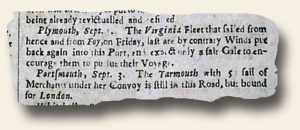 This week’s journey took me to London, England, by the means of The London Gazette dated September 5, 1667. This carried the report from Plymouth the that “The Virginia Fleet sailed from hence, and from Foy, on Friday, last are by contrary Winds put back again into this Port, and expect only a fair Gale to encourage them to pursue their Voyage.” What a great reminder as to the difficulties of early trans-Atlantic travel – that which we now take for granted.
This week’s journey took me to London, England, by the means of The London Gazette dated September 5, 1667. This carried the report from Plymouth the that “The Virginia Fleet sailed from hence, and from Foy, on Friday, last are by contrary Winds put back again into this Port, and expect only a fair Gale to encourage them to pursue their Voyage.” What a great reminder as to the difficulties of early trans-Atlantic travel – that which we now take for granted.
~The Traveler
Chuckle for the day…
June 9, 2016 by TimHughes · Leave a Comment
The “Pennsylvania Packet“, Philadelphia, issue of September 24, 1788 contains on page 3: “Dean Swift’s idea of an attorney…”. You can read it for yourself (see below).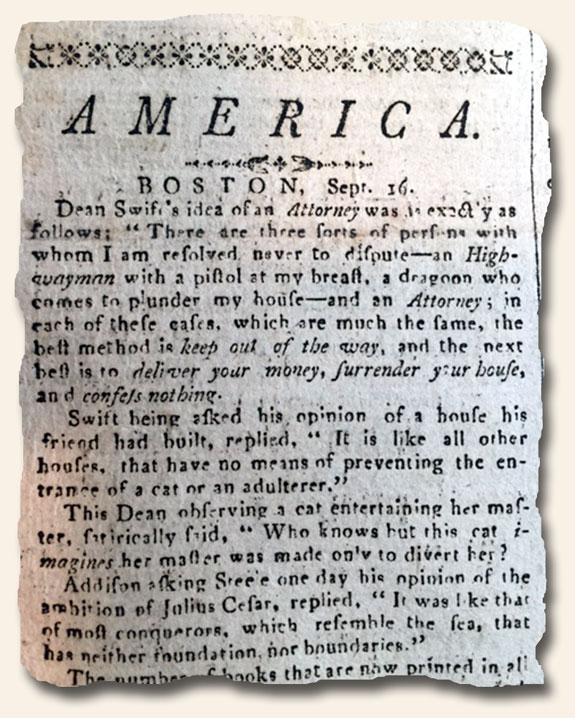
The Traveler… showing the way…
February 4, 2016 by The Traveler · Leave a Comment
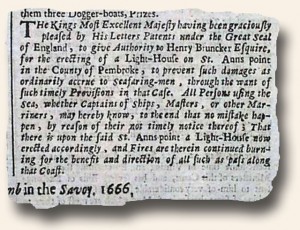 Today I traveled back to England by the way of The London Gazette dated February 4, 1666. The back page has “The Kings Most Excellent Majesty having been graciously pleased… to give Authority… for the erecting of a Light-House on St. Anns point in the County of Pembroke, to prevent such damages as ordinarily accrue to seafaring-men, through the want of such timely Prevision in that Case…” While this original lighthouse no longer stands, there have been two others built in it’s place, with the current lighthouse viewable at: St. Ann’s Lighthouse
Today I traveled back to England by the way of The London Gazette dated February 4, 1666. The back page has “The Kings Most Excellent Majesty having been graciously pleased… to give Authority… for the erecting of a Light-House on St. Anns point in the County of Pembroke, to prevent such damages as ordinarily accrue to seafaring-men, through the want of such timely Prevision in that Case…” While this original lighthouse no longer stands, there have been two others built in it’s place, with the current lighthouse viewable at: St. Ann’s Lighthouse
~The Traveler
They put it in print… in two different editions…
November 9, 2015 by TimHughes · Leave a Comment
“Newsbooks” from Europe, those small pamphlet-looking periodicals which were the predecessors of today’s newspapers, have always been difficult to find. But rarely have we had a more intriguing issue than one recently added to our inventory, and its the back story which makes it interesting.
Rather than one, we have secured two issues of the “Mecurius Aulicus“newsbook, both of the same date, “The five and thirtieth Weeke” of 1643, one the “regular” Oxford edition, the other the secretly-printed and exceedingly rare London edition.
 This newsbook was created because of the English Civil War during the early 1640’s, as a means for the Royalist faction supporting King Charles I to promote their views in Parliament-held London. It was published in Oxford, the stronghold of Charles I at the time. Any person or any publication promoting the cause of Charles I would not have been welcomed in London. It was a short-lived publication which began to lose support from 1644 onward as the Royalist losses on the battlefield continued. This Oxford newsbook found it more & more difficult to obtain current news and issues became badly delayed. It finally ceased publication in 1645.
This newsbook was created because of the English Civil War during the early 1640’s, as a means for the Royalist faction supporting King Charles I to promote their views in Parliament-held London. It was published in Oxford, the stronghold of Charles I at the time. Any person or any publication promoting the cause of Charles I would not have been welcomed in London. It was a short-lived publication which began to lose support from 1644 onward as the Royalist losses on the battlefield continued. This Oxford newsbook found it more & more difficult to obtain current news and issues became badly delayed. It finally ceased publication in 1645.
But an intriguing article in Wikipedia adds an interesting tidbit to the history of this publication: “…The Mercurius Aulicus was printed in Oxford, which was at this time the Royalist capital…then smuggled into London where it was sold by local women, often at heavily inflated prices. It was also reprinted on occasion–albeit not necessarily accurately–by local sympathizers in London…”.
So as we see, there was also a secretly-printed edition done in London, with print runs which had to be exceedingly low. On the rare occasion we have had the opportunity to offer an issue of the Mercurius Aulicus it has always been the Oxford edition. Never have we seen a London edition. Until now.
The photos show the complete text of not only the “regular” Oxford edition but the very rare London edition as well. Comparing the two gives evidence to some subtle differences between them (embellishment at top of front page is different; heading type sizes are different; embellished first letter of ftpg. is different; dated headings on inside pages are different, etc.) Although I am struck but the considerable similarity between the two issues given they were printed on different presses in different cities, put side-by-side several differences are very evident.
Not only is this London edition very rare, but we were fortunate enough to secure the Oxford edition of the same date as well. If ever a pair of same-date newsbooks deserve to be kept together, here it is. A fascinating pair from an intriguing period in British history—and in newspaper history as well.
Edward Cave Junior, and his Gentleman’s Magazine…
March 24, 2014 by GuyHeilenman · Leave a Comment
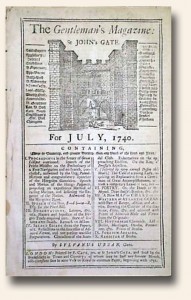 A few months ago we wrote about what is considered by many to be the most successful literary magazine of all time, The Gentleman’s Magazine. While RareNewspapers.com continues to offer many original issues of this title from the 18th and early 29th centuries, few know of the magazine’s or its founder, Edward Cave, Junior. A collector friend recently came across a wonderful posting by The Society of 18th-Century Gentleman which goes into considerable detail concerning both. An excerpt includes:
A few months ago we wrote about what is considered by many to be the most successful literary magazine of all time, The Gentleman’s Magazine. While RareNewspapers.com continues to offer many original issues of this title from the 18th and early 29th centuries, few know of the magazine’s or its founder, Edward Cave, Junior. A collector friend recently came across a wonderful posting by The Society of 18th-Century Gentleman which goes into considerable detail concerning both. An excerpt includes:
“…Edward Cave eventually purchased a small print house and shortly after began The Gentleman’s Magazine. The first issue appeared in January of 1731. Cave quickly became a highly respected publisher and businessman, and “a multitude of magazines arose” all over the world. The magazine was soon the most well-known and highly respected publication in the English language. It is widely believed that Mr. Cave was the first person ever to use the term “magazine” to describe a monthly publication of this type…”
If you’ve never perused this little gem, you’ll be pleasantly surprised with its detailed coverage of events of the day.
The 1600’s and 1700’s on a budget…
March 25, 2013 by TimHughes · Leave a Comment
A genuine collectible, over 300 years old, for $60 or less. Is there a field of collecting today which has items of such age– in nice condition–for $60? The hobby of collecting rare & historic newspapers likely sits at the top of what must 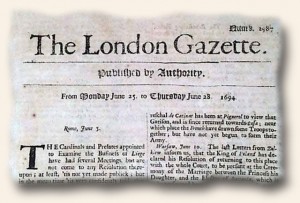 be a very short list. And such prices, along with tremendous availability of titles & content, are part of the intrigue of this fascinating hobby which remains unknown to almost everyone. And this, in large part, is the reason prices are outrageously low in comparison to the relative rarity of other collectibles. While issues do run the gamut price-wise from newsbooks (at the upper end) to coffeehouse newspapers (typically at the lower end), it is a fascinating field for the historical hobbyist on a budget ($20 and under).
be a very short list. And such prices, along with tremendous availability of titles & content, are part of the intrigue of this fascinating hobby which remains unknown to almost everyone. And this, in large part, is the reason prices are outrageously low in comparison to the relative rarity of other collectibles. While issues do run the gamut price-wise from newsbooks (at the upper end) to coffeehouse newspapers (typically at the lower end), it is a fascinating field for the historical hobbyist on a budget ($20 and under).
The ‘London Gazette‘ is the world’s oldest continually published newspaper, having begun in 1665 and is still publishing today. With such historical depth you would expect to find virtually every major event in world history within its pages, and you would be right. The Great Plague and Great London Fire, William Penn being granted land in the New World, the death of noted pirate Captain Kidd, the battles of the French & Indian War and Revolutionary War and so much more are found in not only this title but other newspapers of the era. First reports of such notable events can sell in the thousands of dollars, but an interesting facet of this hobby is that follow-up reports of a few days later can fall well within the comfort level of the average collector.
Both age and graphic appeal come together in the London ‘Post-Boy‘ newspaper, with issues from the 1718-1725 period featuring two ornate engravings in the masthead in addition to a very decorative first letter of the text. Add to this the relative small size of this single sheet newspaper and you have a terrific item for display for under $55.
With American newspapers not beginning until the first decade of the 18th century (one title was published in 1690 but lasted just one day), and most American newspapers through the Revolutionary War being very rare, British titles are an excellent source for collecting all the notable events not only in American history, but in world history as well. And the reporting was often extensive, for remember that the colonies were part of Great Britain through 1776.
The ‘London Chronicle’ was a popular British newspaper which documented amongst its pages virtually all American events since its founding during the French & Indian War. Yet another periodical, the ‘Gentleman’s Magazine‘, is an 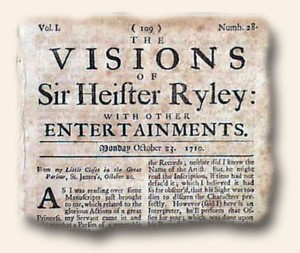 excellent source for period reports of American events since its beginning in 1731, and one of its features was the printing of maps of all corners of the globe, many of which show North America and specific colonies. From James Oglethorpe’s settling the colony of Georgia, to Ben Franklin‘s famous kite experiment, installation of the Liberty Bell, the enactment & repeal of the hated Stamp Act, all events of the Revolutionary War, to the mutiny on the Bounty & so much more, the ‘Gentleman’s Magazine’ offers a terrific repository of American and world history at very affordable prices. Plus, there are reports of Colonel George Washington from 1754 when he was just 22 years old and relatively unknown, and for the music buffs there are works by the composers Hayden, Handel, and death reports of Mozart and Beethoven within its pages. The early battles of Napoleon & other European reports are logically found in this title as well.
excellent source for period reports of American events since its beginning in 1731, and one of its features was the printing of maps of all corners of the globe, many of which show North America and specific colonies. From James Oglethorpe’s settling the colony of Georgia, to Ben Franklin‘s famous kite experiment, installation of the Liberty Bell, the enactment & repeal of the hated Stamp Act, all events of the Revolutionary War, to the mutiny on the Bounty & so much more, the ‘Gentleman’s Magazine’ offers a terrific repository of American and world history at very affordable prices. Plus, there are reports of Colonel George Washington from 1754 when he was just 22 years old and relatively unknown, and for the music buffs there are works by the composers Hayden, Handel, and death reports of Mozart and Beethoven within its pages. The early battles of Napoleon & other European reports are logically found in this title as well.
While American newspapers of the Revolutionary War and before are generally pricey, ranging in the $400 – $1000+ range, two notable exceptions exist being the ‘Boston Chronicle’ and the ‘Pennsylvania Chronicle’, both from the 1768-1769 years. Because their circulation was widespread they are among the more commonly held colonial titles by institutions, & consequently come on the market when libraries convert from hard copy to microfilm or digital. They detail the entire spectrum of American life from just before the Revolutionary War while providing an interesting perspective on American politics during those critical years. Complete, genuine issues are typically available for under $200.
American newspapers from after the American Revolution become more available and at dramatically lower prices while still containing a wealth of notable content on the founding years of the federal government. The ‘Pennsylvania Packet’ of Philadelphia was one of the more successful titles, and was the very first to print the Constitution of the United States. While that issue, September 19, 1787, ranks well into six figures,  dates surrounding it are typically found in the $45 – $80 range and offer a perspective of life in the city where and when the Constitution was being created. The ‘Columbian Centinel’ from Boston was perhaps the most successful title in 18th century America and its pages document the complete scope of America politics and life from 1785 thru Washington’s election and inauguration to his death just weeks before the end of the century.
dates surrounding it are typically found in the $45 – $80 range and offer a perspective of life in the city where and when the Constitution was being created. The ‘Columbian Centinel’ from Boston was perhaps the most successful title in 18th century America and its pages document the complete scope of America politics and life from 1785 thru Washington’s election and inauguration to his death just weeks before the end of the century.
Other 18th century American titles which are within the budgets of even the most modest collectors are the ‘Connecticut Courant’, ‘Dunlap’s American Daily Advertiser’, ‘Gazette of the United States’, the ‘Massachusetts Spy’, and ‘The Herald, A Gazette For The Country’ and others. Nice issues from the formative years of the federal government can be had for under $50 each.
While first reports of the most historic events of the 17th and 18th centuries will always command top dollar among the most savvy of collectors, the hobby of collecting rare newspapers offers a tremendous wealth of issues at surprisingly low prices, while at the same time offering fascinating content on life only known to others through history books. And this hobby is one that offers the entire spectrum of political, economic, and social history to every collector. What other hobby can make that claim? But perhaps most importantly, this hobby let’s you hold—quite literally—history in your hands.




